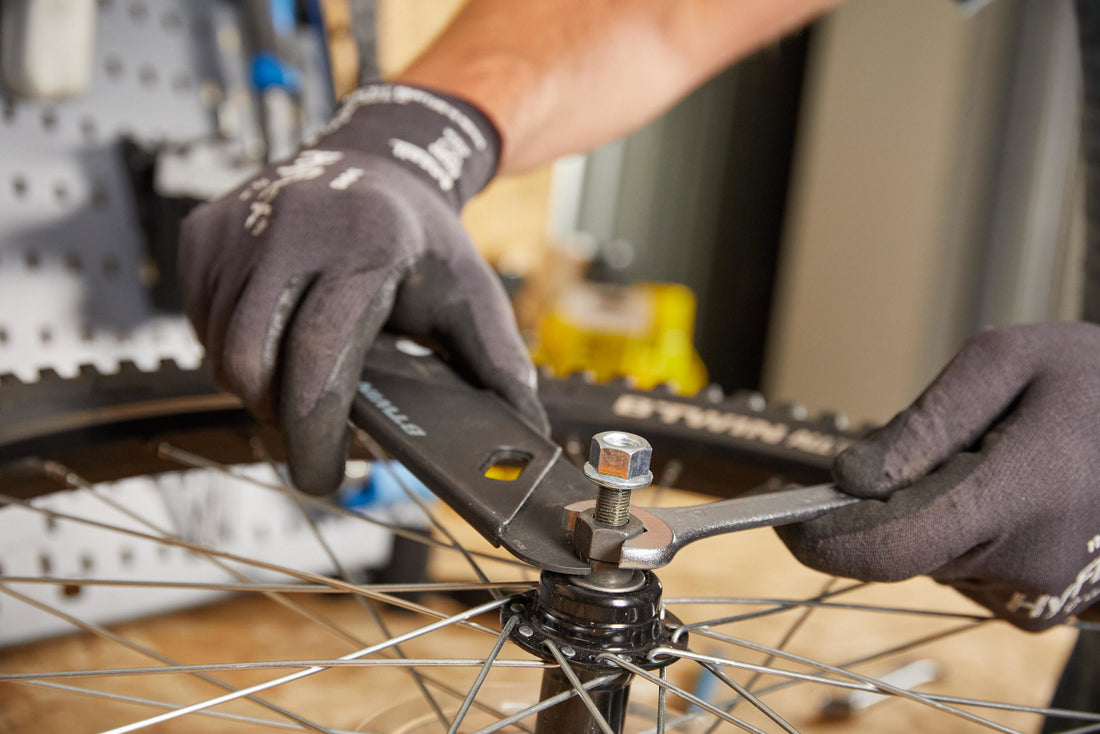Mountain biking is synonymous with getting away, exploring nature and going on adventures. But between forests and mountains, mud and rocks, your bike is put to the test! How do you care for it after a ride? How do you clean and maintain your mountain bike chain? How do you clean your and your child's mountain bike? Thomas, cycling pro and kids' bikes product manager at B'TWIN, gives us his best tips!
Chain, cassette...How do you clean your bike properly?
"You shouldn't underestimate the importance of cleaning when it comes to caring for your mountain bike. It removes most of the dirt and mud that can, over time, cause damage. Here are a few tips to do things right. To start, avoid high pressure water! The pressure of the water can damage the paint and parts on your bike. Opt for a simple, effective stream of water. Next, I would recommend getting a bucket of hot water, dish soap and a sponge. For more picky riders, there are even specific soaps for bikes. Lastly, remember to clean the bike's chain (drive train) and the cassette with the rear derailleur, these are key parts that you have to maintain to increase the lifespan of your bike. Cleaning kits with specialized brushes are also available to help you reach nooks and crannies when washing your mountain bike. This will let you get a real deep clean."
The importance of drying your bike
"It's important! I would strongly warn against skipping this step. If, for example, you don't dry around the drive train, water will stagnate and can cause rust spots, especially if the chain was not cleaned well. Just a plain rag will do the trick. If there are any perfectionists among us, you can also finish with a high pressure air hose. You can make your bike look just like new after a ride, which, you have to admit, is pretty satisfying!"
Don't forget: make sure your bike has been properly dried. If any water remains on the parts, any grease or lubricant you apply will be less effective...
Mountain bike cleaning: when to clean your drive train and how to oil your mountain bike
The drive train is a bit like the motor on your car: it's essential to the proper functioning of your bike. Thomas explains how to lubricate your mountain bike:
"Keep in mind that the drive train is the most important part of your bike: bottom bracket shell, pedals, chain, cogs, etc. To keep everything in good shape, I would recommend degreasing the drive train after each ride with a suitable degreasing product that removes dust and dirt that builds up and can be harmful to its proper functioning. After using the degreaser, remember to then regrease the drive train to make it easier to change speeds."
Our tip: after lubing the drive train, pedal and switch speeds so that you use all of the cogs and gears. This ensures your drive train works properly.
Really though, where do you clean your mountain bike?
If you have a bit of extra space in your garden, apartment courtyard or even your road, we recommend doing it at home: a bucket, sponge, rag and a few cleaning products will do the job. Avoid the car wash, high pressure water can damage parts on your bike!
And if you don't have the products you need at home, you can find all the cleaning products you need for your bike here!
Bike upkeep starts with your brakes!
"I would also say that you need to check your bike's brakes often, whether they’re rim brakes or disc brakes. For rim brakes, make sure that they're not too worn with mud. There's no easier way to do it, just check the wear indicator. You can also find out just by pressing on the brake lever. If at the end of your ride, it takes you longer to stop, then they're starting to wear out. Frequent checks and good habits can help you avoid nasty surprises when out on a ride!"
Do you have to reinflate your tires after a ride?
"It all depends on your next ride. If you have already been riding and want to use your bike the next day, the answer is yes. But if your next ride isn't for two to three weeks later, skip reinflation. The inner tube is porous by nature so if you don't plan on riding in the next few days, the tires will deflate. The best option is to reinflate your tires just before leaving. You can use this time to ensure there aren't any foreign objects in a tire or a puncture hole. One last tire tip, I recommend regularly checking the tread for wear. A worn tire tread can become slick and reduce your grip. If you want to ride a significant distance, you can check the stem's tightness (the part that holds the handlebars) and the handlebars themselves."
A short summary:
1. Check that there aren't any foreign objects
2. Check the wear of the tread
3. If the tread is smooth, you risk having worse grips on rides
How to protect your bike from damage
"For example, on mountain bikes with disc brakes, when you degrease the bike's chain, you have to make absolutely sure not to get grease on the disc brakes or rim brakes. Your brakes might just stop...braking! Or again, I've even seen riders tighten their steering system by adjusting the screws on the stem too much. Here again you have to be careful, because tightening these torx screws too tightly can break the system. So I do not recommend doing it yourself if you're not completely confident. Instead, head into one of our workshops so that you can be guaranteed that all parts work perfectly. "
















